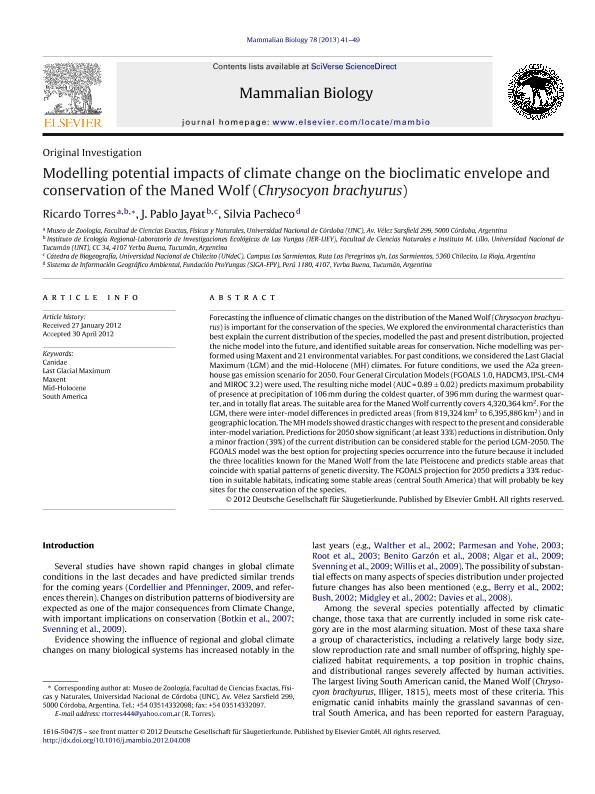Artículo
Modelling potential impacts of climate change on the bioclimatic envelope and conservation of the Maned Wolf (Chrysocyon brachyurus)
Fecha de publicación:
06/2012
Editorial:
Elsevier
Revista:
Mammalian Biology
ISSN:
1616-5047
Idioma:
Inglés
Tipo de recurso:
Artículo publicado
Clasificación temática:
Resumen
Forecasting the influence of climatic changes on the distribution of the Maned Wolf (Chrysocyon brachyurus) is important for the conservation of the species. We explored the environmental characteristics than best explain the current distribution of the species, modelled the past and present distribution, projected the niche model into the future, and identified suitable areas for conservation. Niche modelling was performed using Maxent and 21 environmental variables. For past conditions, we considered the Last Glacial Maximum (LGM) and the mid-Holocene (MH) climates. For future conditions, we used the A2a greenhouse gas emission scenario for 2050. Four General Circulation Models (FGOALS 1.0, HADCM3, IPSL-CM4 and MIROC 3.2) were used. The resulting niche model (AUC = 0.89 ± 0.02) predicts maximum probability of presence at precipitation of 106 mm during the coldest quarter, of 396 mm during the warmest quarter, and in totally flat areas. The suitable area for the Maned Wolf currently covers 4,320,364 km2. For the LGM, there were inter-model differences in predicted areas (from 819,324 km2 to 6,395,886 km2) and in geographic location. The MH models showed drastic changes with respect to the present and considerable inter-model variation. Predictions for 2050 show significant (at least 33%) reductions in distribution. Only a minor fraction (39%) of the current distribution can be considered stable for the period LGM-2050. The FGOALS model was the best option for projecting species occurrence into the future because it included the three localities known for the Maned Wolf from the late Pleistocene and predicts stable areas that coincide with spatial patterns of genetic diversity. The FGOALS projection for 2050 predicts a 33% reduction in suitable habitats, indicating some stable areas (central South America) that will probably be key sites for the conservation of the species.
Palabras clave:
Canidae
,
Last Glacial Maximum
,
Maxent
,
Mid-Holocene
,
South America
Archivos asociados
Licencia
Identificadores
Colecciones
Articulos(SEDE CENTRAL)
Articulos de SEDE CENTRAL
Articulos de SEDE CENTRAL
Citación
Torres, Ricardo Marcelo; Jayat, Jorge Pablo; Pacheco, Silvia; Modelling potential impacts of climate change on the bioclimatic envelope and conservation of the Maned Wolf (Chrysocyon brachyurus); Elsevier; Mammalian Biology; 78; 1; 6-2012; 41-49
Compartir
Altmétricas




